-
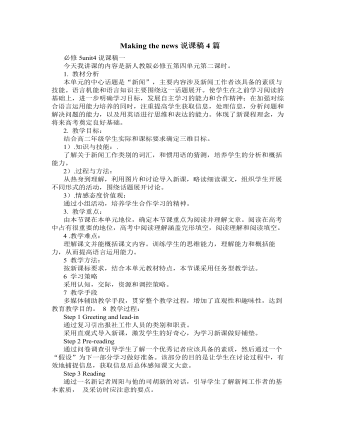
人教版高中英语必修5Making the news说课稿4篇
今天我们来介绍一下必修五第四单元的授课方式。这个单元的题目是Making the news。应该是学生比较感兴趣的话题,学生往往对新闻工作充满好奇,所以我们可以利用这个机会多设计一些师生互动和学生互动,来激发起学习的积极性,提高学习效率。同时我们可以利用这个单元不仅帮助学生掌握语言知识,培养语言能力,同时让其了解新闻工作的重要性,培养起社会智能感。这个单元分为六个课时,它的教学目标是这样的:语言目标是掌握词汇表中的常用单词和短语,掌握倒装句的一些基本用法。 技能目标是能初步掌握约会的基本句型并在真实的场景下正确运用。新闻报道类文章的写作技能。采访的基本规范和沟通技能。情感目标是对新闻报道的客观性和真实性有更好的理解。对新闻记者的职业有更深入的了解,并能体会其工作的重要性。下面我们来介绍一下第一课时的授课方式,第一课的教学目标是这样的第一课时的教学目标语言目标:单词:Occupation, journalist, editor, photographer, curious, personality, enthusiasm
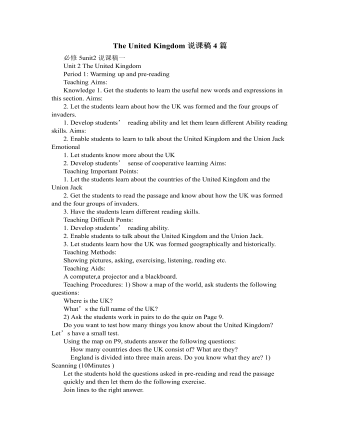
人教版高中英语必修5The United Kingdom说课稿4篇
Teaching Aims:Knowledge 1. Get the students to learn the useful new words and expressions in this section. Aims:2. Let the students learn about how the UK was formed and the four groups of invaders.1. Develop students’ reading ability and let them learn different Ability reading skills. Aims:2. Enable students to learn to talk about the United Kingdom and the Union Jack Emotional 1. Let students know more about the UK2. Develop students’ sense of cooperative learning Aims:Teaching Important Points:1. Let the students learn about the countries of the United Kingdom and the Union Jack2. Get the students to read the passage and know about how the UK was formed and the four groups of invaders.3. Have the students learn different reading skills.Teaching Difficult Ponts:1. Develop students’ reading ability.2. Enable students to talk about the United Kingdom and the Union Jack.3. Let students learn how the UK was formed geographically and historically.Teaching Methods:Showing pictures, asking, exercising, listening, reading etc.Teaching Aids:A computer,a projector and a blackboard.Teaching Procedures: 1) Show a map of the world, ask students the following questions:Where is the UK?What’s the full name of the UK?2) Ask the students work in pairs to do the quiz on Page 9.Do you want to test how many things you know about the United Kingdom? Let’s have a small test.Using the map on P9, students answer the following questions:?How many countries does the UK consist of? What are they??England is divided into three main areas. Do you know what they are? 1) Scanning (10Minutes )Let the students hold the questions asked in pre-reading and read the passagequickly and then let them do the following exercise.Join lines to the right answer.
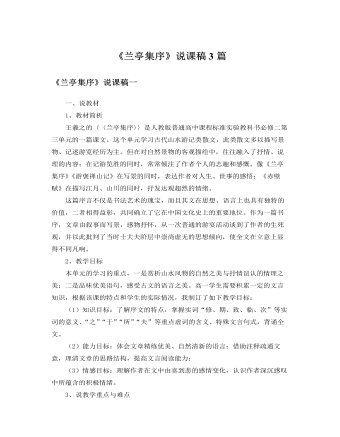
人教版高中语文必修2《兰亭集序》说课稿3篇
(二)分析课文,理清思路第1、2段为第一部分,主要是叙事、写景,先叙述集会的时间、地点,然后渲染出兰亭优美的自然环境。在这里足以“游目骋怀”“极视听之娱”,可以自由地观察、思考,满足人们目视耳闻的需求。这里正是与会“畅叙幽情”、尽兴尽欢的绝好处所。这些描写都富有诗情画意,作者的情感是轻松愉快的。第3、4段为第二部分,主要是抒情、议论,作者由美景妙时引发出乐与忧、生与死的感慨。他认为人生的快乐是有极限的,待快乐得到满足时,就会感觉兴味索然。往事转眼间便成为历史,人到了生命的尽头就会死亡。作者由“一死生为虚诞,齐彭殇为妄作”的认识,产生了一种珍惜时间、眷恋生活、热爱文明的思考。虽然文中的寿夭、生死不能自由决定,从而有些伤感,但作者仍然认识到盛衰、生死是必然的。人生无常,时不我待,故著文留传后世,以承袭前人,启示来者。
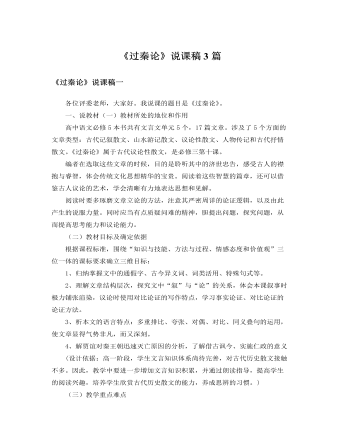
人教版高中语文必修3《过秦论》说课稿3篇
本文篇幅较长,并且有一字句不易理解,因而对高一学生来说完全读懂内容有一些困难。这样的话,老师就要做好引导工作,把一些难点,或是出现词类活用比较多,局势比较特殊的句子,老师可以先给学生画出来,存疑,或是与同学们一起讨论解决。对那些不易懂的字词就引导学生联系上下文提供的语境、前后涉及的情节加以推测、判断,以培养学生依据文脉推断词义的好方法。要求学生点出重点实词、框出通假字,主要是为帮助学生积累和掌握一些文言文中常见的一词多义、异读现象、古今异义和通假现象的词语,并进一步得出规律,指导今后的文言文学习。词类活用和特殊句式在文言文翻译中难度较大,也是本文教学的两大难点。要求学生标出有活用现象的字和划出句式特殊的句子,是基于两点考虑:1、积累一定数量的第一手例句;2、引导学生加以分类,找出每类的相同特征,并抽取出来形成规律性的东西,从而上升到理性认识,使学生能由学会一个到会学多个。翻译过程中注重指导学生养成用符号法表示重点字句的好习惯,如点、框、圈、划线等符号应约定一致,便于突出翻译中的重点、难点及复习。我的提示着重归纳了实词“制”“亡”“遗”“利”等,名词活用、形容词活用、使动用法,被动句、状语后置句。
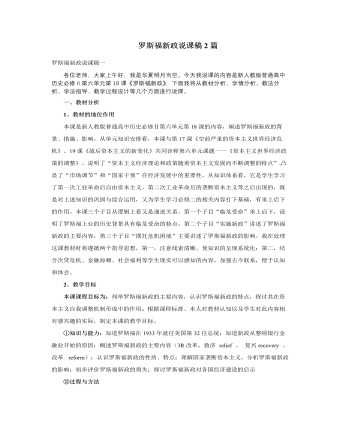
人教版高中历史必修2罗斯福新政说课稿2篇
1、教材的地位作用本课是新人教版普通高中历史必修Ⅱ第六单元第18课的内容,阐述罗斯福新政的背景、措施、影响。从单元知识安排看,本课与第17课《空前严重的资本主义世界经济危机》、19课《战后资本主义的新变化》共同诠释第六单元课题——《资本主义世界经济政策的调整》。说明了“资本主义经济理论和政策随着资本主义发展而不断调整的特点”,凸显了“市场调节”和“国家干预”在经济发展中的重要性。从知识体系看,它是学生学习了第一次工业革命后自由资本主义、第二次工业革命后的垄断资本主义等之后出现的,既是对上述知识的巩固与综合运用,又为学生学习必修二的相关内容打下基础,有承上启下的作用。本课三个子目从逻辑上看又是递进关系。第一个子目“临危受命”承上启下,说明了罗斯福上台的历史背景具有临危受命的特点,第二个子目“实施新政”讲述了罗斯福新政的主要内容,第三个子目“摆托危机困境”主要讲述了罗斯福新政的影响。
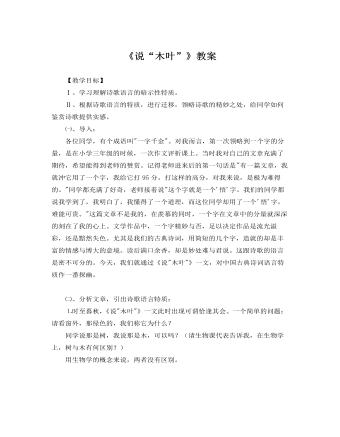
人教版高中语文必修5《说“木叶”》教案
【教学目标】Ⅰ、学习理解诗歌语言的暗示性特质。Ⅱ、根据诗歌语言的特质,进行迁移,领略诗歌的精妙之处,给同学如何鉴赏诗歌提供实感。㈠、导入:各位同学,有个成语叫"一字千金"。对我而言,第一次领略到一个字的分量,是在小学三年级的时候,一次作文评析课上。当时我对自己的文章充满了期待,希望能得到老师的赞赏。记得老师进来后的第一句话是"有一篇文章,我就冲它用了一个字,我给它打95分。打这样的高分,对我来说,是极为难得的。"同学都充满了好奇,老师接着说"这个字就是一个'悟'字。我们的同学都说我学到了,我明白了,我懂得了一个道理,而这位同学却用了一个'悟'字,难能可贵。"这篇文章不是我的,在羡慕的同时,一个字在文章中的分量就深深的刻在了我的心上。文学作品中,一个字精妙与否,足以决定作品是流光溢彩,还是黯然失色。尤其是我们的古典诗词,用简短的几个字,造就的却是丰富的情感与博大的意境。读后满口余香,却是妙处难与君说。这跟诗歌的语言是密不可分的。今天,我们就通过《说"木叶"》一文,对中国古典诗词语言特质作一番探幽。
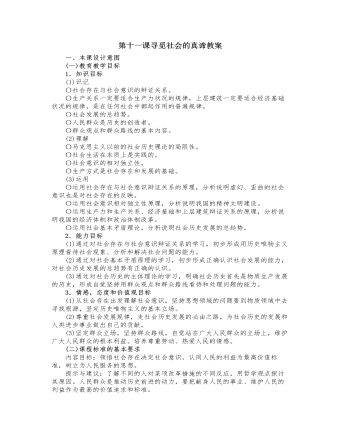
人教版高中政治必修4第十一课寻觅社会的真谛教案
思考提示在阶级社会中,社会基本矛盾的解决主要是通过阶级斗争实现的,阶级斗争是推动阶级社会发展的直接动力,当旧的生产关系严重阻碍生产力发展,需要进行变革时,代表旧的生产关系的没落阶级却不会自动退出历史舞台,利用旧的上层建筑维护自己的统治,只有代表新生产力发展方向的阶级通过社会革命,推翻没落的阶级统治,才能解放生产力,推动社会向前发展。所以,阶级社会的进步往往是通过激烈的社会革命实现的。但是,社会主义社会与阶级社会不同,这是因为,社会主义社会中,生产力和生产关系、经济基础和上层建筑之间的矛盾是一种非对抗性矛盾,不需要通过一个阶级推翻另一个阶级的阶级斗争的方式来解决,只能通过改革实现社会的发展,通过对生产关系和上层建筑进行改革,实现社会主义的自我完善,从而促进社会的发展。所以,我国经济体制改革是在坚持社会主义制度的前提下,改革生产关系和上层建筑中不适应生产力发展的一系列相互联系的环节和方面。
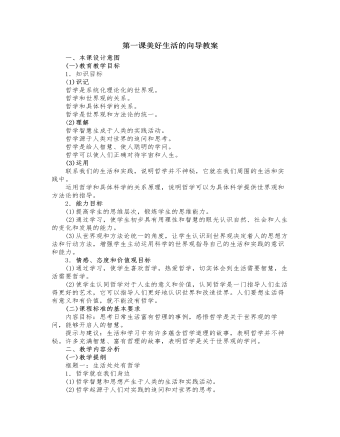
人教版高中政治必修4第一课美好生活的向导教案
3.柏拉图(公元前427一前347)古希腊哲学家。生于雅典。苏格拉底的弟子,亚里士多德的老师。他曾在雅典创办学园,收徒讲学,逐步建立起欧洲哲学史上第一个客观唯心主义体系。他也是欧洲哲学史上第一个有大量著作传世的哲学家。他提出世界的本源是“理念”,现实中的事物都是“理念”的摹本。人的知识来源于对“理念”的回忆。柏拉图的哲学思想对后世影响很大,有人说,柏拉图之后的欧洲哲学思想都是对柏拉图思想的注脚。4.黑格尔(1770—1t53l)19世纪德国古典哲学家,客观唯心主义者、辩证法大师。生于斯图加特,卒于柏林。出身于官僚家庭。曾在图宾根神学院学习哲学和神学。大学毕业后,做过几年家庭教师。后任报纸编辑、中学校长、大学讲师、教授和柏林大学校长。黑格尔是在法国革命的直接影响下成长起来的,青年时朝气蓬勃,非常激进。他还深受著名诗人歌德的影响。1818年,他到柏林大学任教后,公开美化普鲁士专制制度,号召人们同现实妥协。
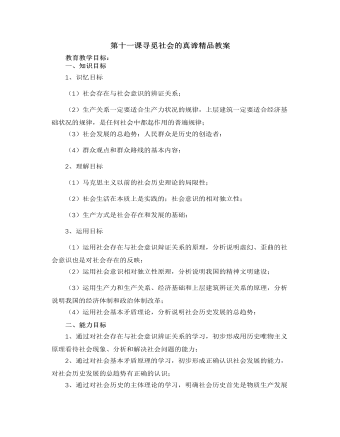
人教版高中政治必修4第十一课寻觅社会的真谛精品教案
A生产方式是人类社会存在和发展的基础人要生存必须有吃、穿、住、用等物质生活资料,只有生存问题解决了才能谈得上社会的存在和发展,才能从事其他的活动(教育、艺术、体育、政治)。而要获得物质生活资料,必须从事物质资料的生产劳动。在这一活动中,形成了现实的生产力和生产关系,即生产方式。【思想教育】落后必然挨打,我国大力发展经济,就是为了发展生产力。发展是硬道理,中国解决一切问题的关键在与自己的发展。要积极支持改革开放,积极投身于经济建设中去。现在学好知识将来教育育人,为社会培养更多的合格人才。B生产方式决定着社会的性质和面貌社会生活纷繁复杂,包括经济生活、政治生活、精神生活、婚姻家庭生活等许多方面。这些方面都受生产方式的制约,有什么样的生产方式,就有什么样的社会结构;不同的生产方式,表现为不同性质的社会形态。社会的整个面貌只能从生产方式中得到科学的说明。【举例】家庭联产承包责任制的产生与推广1958年的人民公社化运用曾使中国农民在劳动和分配上都实行绝对的平均主义,大锅饭的结果是饭越吃越少,人越过越穷。
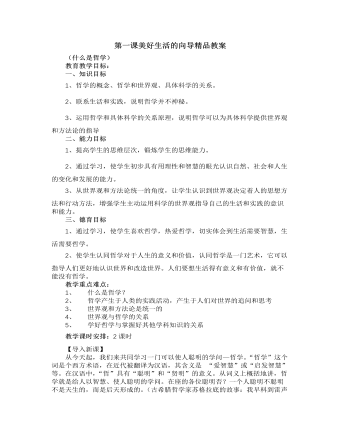
人教版高中政治必修4第一课美好生活的向导精品教案
b哲学为具体科学提供世界观和方法论的指导每一个时代的具体科学的发展,总是受到这个时代哲学思想的影响和支配。任何一个科学家都有自己的哲学信仰,都用一定的哲学世界观来指导自己的研究。缺乏正确的世界观和方法论的指导,就会在研究中失去正确方向,甚至陷入混乱和失败。【举例】牛顿晚年误入歧途牛顿早年在自发的唯物主义世界观的指导下,发现了万有引力定律,谱写了人类物理史上的辉煌篇章。他谦虚地说,他是站在巨人们的肩膀上,拾取了知识大海里一个晶莹美丽的贝壳。但在他的后半生,居然虔诚地投入上帝地怀抱,用25年的时间研究神学,写了100多万字有关神学和宗教的书稿。牛顿是一个虔诚的宗教信徒,自幼受到信奉上帝的教育,这对他的世界观影响极深,加之他所处的时代是形而上学统治自然科学的时代,在错误的世界观的支配下,他将解释不了的现象求助于上帝,如“从上帝那里去寻找行星围绕太阳公转的第一推动力”,结果一事无成。
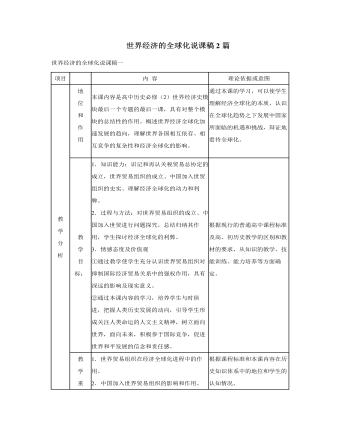
人教版高中历史必修2世界经济的全球化说课稿2篇
【合作探索】经济全球化和经济区域集团化的关系?相互促进,相互制约。促进:经济全球化不平衡导致经济区域集团化,区域集团化是经济全球化的具体表现,经济区域集团化是最终实现经济全球化的重要步骤和途径,经济全球化则是区域经济集团化的最终归宿。制约:但经济区域集团化短期内对全球化不利。过渡:经济全球化让世界得以发展,但也有不公平的因素,那么,谁来维护公平了?二 、世界贸易组织的建立师:世界贸易组织建立的主要原因是什么?生:⑴经济全球化的发展迅速;⑵关贸总协定存在许多弊端,不适应经济全球化发展的要求师:它是怎样建立起来的?生:①1986年: 意大利 提出倡议②1993年:乌拉圭回合谈判——把多边贸易组织改名为世界贸易组织③1994年: 正式决定建立WTO④1995.1.1:WTO正式开始运作师:世贸组织特点是什么?宗旨是什么?生:规范化 法制化。促进各国市场开放,调解贸易纠纷,实现全球范围内的贸易自由化
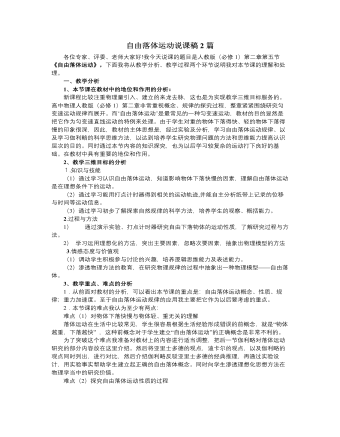
人教版新课标高中物理必修1自由落体运动说课稿2篇
学生回答的方法多样,让各小组根据自己讨论出来的方法对自己实验出来的纸带进行数据处理,并求出加速度,并且将多条纸带都进行处理,同时提醒学生对纸带的选择。接着,我会用多媒体展示重物下落实验打出来的纸带,用表格列出一段纸带上各点的瞬时速度,准确画出v-t图像,求出加速度,将结果给予学生的结果作对比,确定出正确结论。最后让学生分析总结:自由落体运动是初速度为零的匀加速直线运动,而且,多条纸带算出来的加速度的数值都接近相等,即加速度在实验误差允许范围内是相等的。引出重力加速度,介绍概念、方向及大小。(强调“同一地点”,让学生阅读教材中一些地点的重力加速度,可以了解重力加速度的大小与纬度有关,纬度越大加速度越大)。学习了重力加速度后让学生根据之前学习的匀变速直线运动公式推导出自由落体的运动规律。设计意图:让学生在学习过程中的主体地位和自主观能动性得到充分发挥,取长补短,培养了学生的实验操作能力,又使学生对自由落体运动的性质有深刻的印象,从而解决了本节课第二个难点。
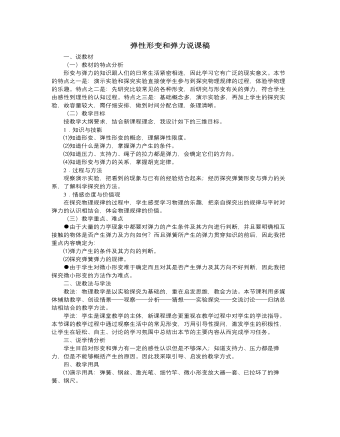
人教版新课标高中物理必修1弹性形变和弹力说课稿
在同一个直角坐标,做出两个不同弹簧的F—X图象,然后进行比较。图象法处理数据更为直观,更容易得出物理变化规律,且该种方法处理数据能更好地减小实验的偶然误差。最后老师归纳总结:得出胡克定律:F=KX(K为弹簧的颈度系数)[设计意图:在探究弹力的大小与形变的定量关系时,由学生进行猜想、实验和得出规律,并利用信息技术计算机绘制F—X图象,充分利用信息技术资源和物理学科的整合。能较好地体现以学生为主的新的教学理念。对探究实验过程教师加以指导,使学生学会团结合作、学会探究物理规律;再加上熟练信息技术,更有效地提高学习效率。](五)弹力的应用(图片,视频播放:射箭)[设计意图:让学生知道产品设计离不开物理理论,做到从实践到理论,再从理论到实践的学习过程。](六)开放式问题(视频播放:撑杆跳高、跳水);提出问题:通过本节内容的学习,请同学们开放式地讨论①从形变与弹力知识去思考,撑杆跳高运动员跳得这么高的主要原因是什么?②跳水运动员在空中滞空时间主要由哪方面决定?
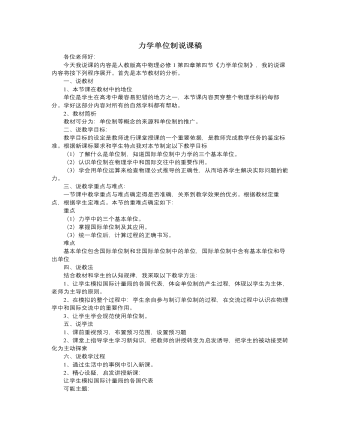
人教版新课标高中物理必修1力学单位制说课稿
今天我说课的内容是人教版高中物理必修1第四章第四节《力学单位制》,我的说课内容将按下列程序展开。首先是本节教材的分析。一、说教材1、本节课在教材中的地位单位是学生在高考中最容易犯错的地方之一,本节课内容贯穿整个物理学科的每部分。学好这部分内容对所有的自然学科都有帮助。2、教材简析教材可分为:单位制等概念的来源和单位制的推广。二、说教学目标:教学目标的设定是教师进行课堂授课的一个重要依据,是教师完成教学任务的鉴定标准。根据新课标要求和学生特点我对本节制定以下教学目标(1)了解什么是单位制,知道国际单位制中力学的三个基本单位。(2)认识单位制在物理学中和国际交往中的重要作用。(3)学会用单位运算来检查物理公式推导的正确性,从而培养学生解决实际问题的能力。
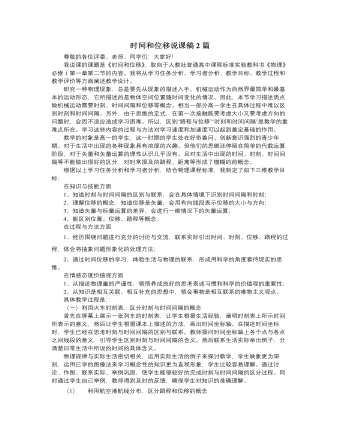
人教版新课标高中物理必修1时间和位移说课稿2篇
研究一种物理现象,总是要先从现象的描述入手。机械运动作为自然界最简单和最基本的运动形态,它所描述的是物体空间位置随时间变化的情况。因此,本节学习描述质点做机械运动需要时刻、时间间隔和位移等概念。相当一部分高一学生在具体过程中难以区别时刻和时间间隔。另外,由于思维的定式,在第一次接触既要考虑大小又要考虑方向的问题时,会因不适应造成学习困难。所以,区别“路程与位移”“时刻和时间间隔”是教学的重难点所在。学习这些内容的过程与方法对学习速度和加速度可以起到奠定基础的作用。教学的对象是高一的学生,这一时期的学生处在好奇善问、创新意识强烈的青少年期。对于生活中出现的各种现象具有浓厚的兴趣。但他们的思维还停留在简单的代数运算阶段,对于矢量和矢量运算的理性认识几乎没有。且对生活中出现的时间、时刻、时间间隔等不能做出很好的区分,对时常提及的路程、距离等形成了模糊的前概念。
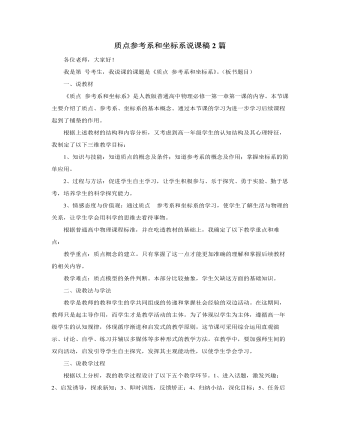
人教版新课标高中物理必修1质点参考系和坐标系说课稿2篇
一、说教材《质点 参考系和坐标系》是人教版普通高中物理必修一第一章第一课的内容。本节课主要介绍了质点、参考系、坐标系的基本概念。通过本节课的学习为进一步学习后续课程起到了铺垫的作用。根据上述教材的结构和内容分析,又考虑到高一年级学生的认知结构及其心理特征,我制定了以下三维教学目标:1、知识与技能:知道质点的概念及条件;知道参考系的概念及作用;掌握坐标系的简单应用。2、过程与方法:促进学生自主学习,让学生积极参与、乐于探究、勇于实验、勤于思考,培养学生的科学探究能力。3、情感态度与价值观:通过质点 参考系和坐标系的学习,使学生了解生活与物理的关系,让学生学会用科学的思维去看待事物。根据普通高中物理课程标准,并在吃透教材的基础上,我确定了以下教学重点和难点:教学重点:质点概念的建立。只有掌握了这一点才能更加准确的理解和掌握后续教材的相关内容。
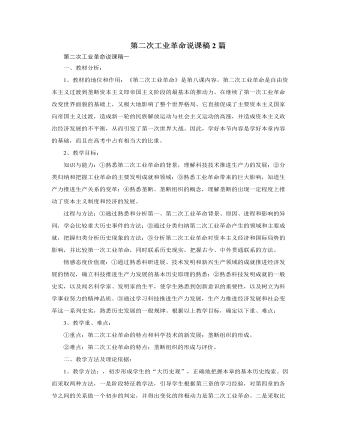
人教版高中历史必修2第二次工业革命说课稿2篇
②内燃机的发明推动了交通运输领域的革新。19世纪末,新型的交通工具——汽车出现了。1885年,德国人卡尔·本茨成功地制成了第一辆用汽油内燃机驱动的汽车。1896年,美国人亨利·福特制造出他的第一辆四轮汽车。与此同时,许多国家都开始建立汽车工业。随后,以内燃机为动力的内燃机车、远洋轮船、飞机等也不断涌现出来。1903年,美国人莱特兄弟制造的飞机试飞成功,实现了人类翱翔天空的梦想,预告了交通运输新纪元的到来。③内燃机的发明推动了石油开采业的发展和石油化学工业的产生。石油也像电力一样成为一种极为重要的新能源。1870年,全世界开采的石油只有80万吨,到1900年猛增至2 000万吨。(3)化学工业的发展:①无机化学工业:用化学反应的方式开始从煤焦油中提炼氨、笨、等,用化学合成的方式,美国人发明了塑料,法国人发明了纤维,瑞典人发明了炸药等。
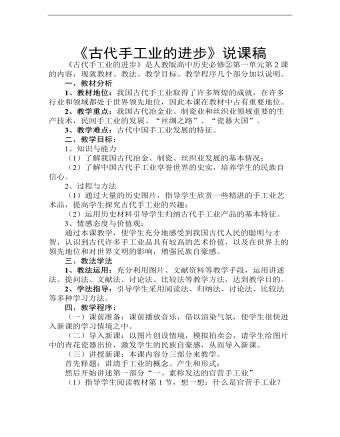
高中历史人教版必修二《第2课古代手工业的进步》说课稿
二、教学目标:1、知识与能力(1)了解我国古代冶金、制瓷、丝织业发展的基本情况;(2)了解中国古代手工业享誉世界的史实,培养学生的民族自信心。2、过程与方法(1)通过大量的历史图片,指导学生欣赏一些精湛的手工业艺术品,提高学生探究古代手工业的兴趣;(2)运用历史材料引导学生归纳古代手工业产品的基本特征。3、情感态度与价值观:通过本课教学,使学生充分地感受到我国古代人民的聪明与才智,认识到古代许多手工业品具有较高的艺术价值,以及在世界上的领先地位和对世界文明的影响,增强民族自豪感。
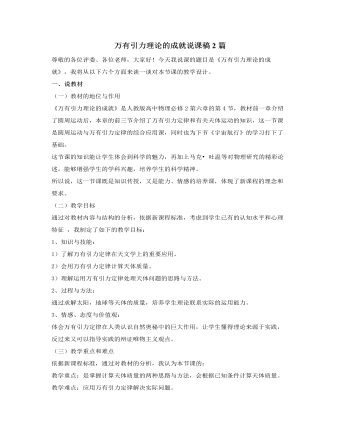
人教版新课标高中物理必修2万有引力理论的成就说课稿2篇
2、计算天体的质量首先观看多媒体展示天体的运动,同时解释什么是环绕天体?什么是中心天体?接着展示相关问题:①应用万有引力定律求解天体质量的基本思路是什么?②求解天体质量的方程依据是什么?教师点拨,学生分组,合作探究,学生代表发言设计说明通过创设问题情境,进行由浅至深,由易到难的问题式教学,以激发学生的积极思维活动;通过探究让学生建立物理模型,分组讨论,求解中心天体质量的三种表达式。在进行已有知识的迁移时重点重复环绕和被绕的关系,使学生准确抓住模型中的各个星体所担任的角色。通过小组合作学习,运用类比归纳法得出正确结论,掌握求解中心天体质量的基本思路,以达到突出教学重点的目的。3、发现未知天体通过2个视频进行了解设计说明这部分通过视频主要激发学生相信科学,学习科学,让学生感知人类探索宇宙的梦想,激发学生探索科学奥秘的热情,培养热爱科学的情感,促使学生树立献身科学的人生价值观。
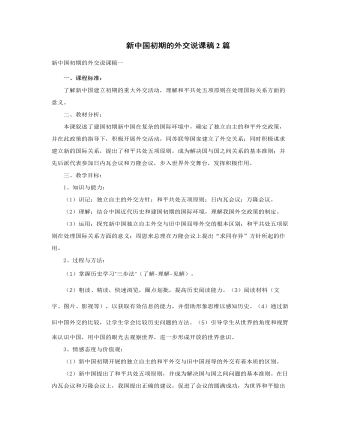
人教版高中历史必修1新中国初期的外交说课稿2篇
四、教学过程1.导入新课(2分钟)出示中非合作论坛暨第3届部长级会议图片。用时事引起学生注意,设问,“55年前,亚洲与非洲有哪一次跨越印度洋的握手”,提示答案“万隆亚非会议”,给出答案导入新课2.外交环境:学生阅读,教师分析。(3分钟)3.外交方针之一:独立自主的和平外交方针(5分钟) 出示材料:《共同纲领》引文。学生、阅读、提炼除新中国奉行独立自主的外交政策。进而由学生分析另起炉灶、打扫干净屋子再请客和一边倒。培养学生分析材料、利用材料的能力过度:新中国作出一边倒大的积极主动态势,社会主义阵营的兄弟们也立刻作出了积极回应。1949年10月2日,中苏建立了外交关系。4.外交建树之一:同苏联等17个国家建立外交关系(3分钟)出示毛泽东访问苏联等图片和第一批建交的17个国家名字





















